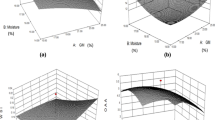Abstract
Considering the evidence of flaxseed and its defatted flaxseed meal (DFM) for human health benefits, response surface methodology (RSM) based on three level four factor central composite rotatable design (CCRD) was employed for the development of DFM incorporated corn – rice flour blend based extruded snack. The effect of DFM fortification (7.5–20 %), moisture content of feed (14–20 %, wb), extruder barrel temperature (115–135 °C) and screw speed (300–330 RPM) on expansion ratio (ER), breaking strength (BS), overall acceptability (OAA) score and water solubility index (WSI) of extrudates were investigated using central composite rotatable design (CCRD). Significant regression models explained the effect of considered variables on all responses. DFM incorporation level was found to be most significant independent variable affecting on extrudates characteristics followed by extruder barrel temperature and then screw rpm. Feed moisture content did not affect extrudates characteristics. As DFM level increased (7.5 % to 20 %), ER and OAA value decreased. However, BS and WSI values were found to increase with increase in DFM level. Based on the defined criteria for numerical optimization, the combination for the production of DFM incorporated extruded snack with desired sensory attributes was achieved by incorporating 10 % DFM (replacing rice flour in flour blend) and by keeping 20 % moisture content, 312 screw rpm and 125 °C barrel temperature.








Similar content being viewed by others
References
Agriculture and Agri-Food Canada (2007). Flaxseed: situation and outlook, Bi-weekly Bulletin 20(3) February 23, 2007, AAFC No. 2081/E
Ahmed ZS (1999) Physico-chemical, structural and sensory quality of corn based flax-snack. Nahrung 4:253–258
Anderson RA, Conway HF, Pfeifer VF, Griffin EL (1969) Gelatinization of corn grits by roll and extrusion cooking. Cereal Sci Today 14:4–12
AOAC (2000) Official methods of analysis, 17th edn. Association of Official Analytical Chemists, Washington DC
Arjmandi BH, Khan DA, Juma S, Drum ML, Venkatesh S, Sohn E, Wei L, Derman R (1998) Whole flaxseed consumption lowers serum LDL- cholesterol and lipoprotein (a) concentrations in postmenopausal women. Nutr Res 18:1203–1214
Asare EK, Sefa-Dedeh S, Afoakwa EO, Sakayi-Dawson E, Budu AS (2012) Extrusion cooking of rice groundnut cowpea mixtures – effects of extruder characteristics on nutritive value and physic-functional properties of extrudates using response surface methodology. J Food Process Preserv 36:465–476
Bell JM, Keith MO (1993) Nutritional evaluation of linseed meals from flax with yellow or brown hulls, using mice and pigs. Anim Feed Sci Technol 43:1–18
Box GEP, Draper N (1987) Empirical model building and response surfaces. John Wiley and sons Inc., New York
Brennan MA, Derbyshire E, Tiwari BK, Brennan CS (2013) Ready-to-eat snack products: the role of extrusion technology in developing consumer acceptable and nutritious snacks. Int J Food Sci Technol 48:893–902
Canadian Grain Commission (2009). Quality of Western Canadian Flaxseed 2009, Export Quality Data, July 2009 http://www.grainscanada.gc.ca/flax-lin/harvest-recolte/2009/hqf09-qrl09-eng.htm
Chakraborty P, Banerjee S (2009) Optimization of extrusion process for production of expanded product from green gram and rice by response surface methodology. J Sci Ind Res 68:140–148
Cochran WG, Cox GM (1957) Experimental Design 2nd edn Wiley Publication in Applied statistics. John Wiley and sons Inc, New York
Collona P, Tayeb J, Mercier C (1989) Extrusion cooking of starch and starchy products. In: Mercier C, Linko P, Harper JM (eds) Extrusion cooking. St. Paul, MN, American Association of Cereal Chemists, pp. 247–319
Cunnane SC, Ganguli S, Menard C (1993) High α-linolenic acid flaxseed (linum usitatissimum): some nutritional properties in humans. Br J Nutr 69:443–453
FAOSTAT (2012). Food and Agicultural Organization of the United Nation. http://faostat3.fao.org/faostat-gateway/go/to/download/Q/QC/E
Faubion JM, Hoseney RC (1982) High-temperature short-time extrusion cooking of wheat starch and flour: II. Effect of protein and lipid on extrudate properties. Cereal Chem 59:533–537
Gan HE, Karim R, Muhammad SKS, Bakar JA, Hashim DM, Rahman RA (2007) Optimization of the basic formulation of a traditional baked cassava cake using response surface methodology. Lebensmittel-Wissenschaft und-Technologie 40:611–618
Ganorkar PM, Jain RK (2013) Flaxseed – a nutritional punch. Int Food Res J 20:519–525
Ganorkar PM, Jain RK (2014a) Effect of microwave roasting on cyanogenic glycosides and nutritional composition of flax seed. Bioinfolet 11:587–590
Ganorkar PM, Jain RK (2014b) Development of flaxseed fortified rice-corn flour blend based extruded product by response surface methodology. J Food Sci Technol. doi:10.1007/s13197-014-1541-1
Gomides AF, Paula SO, Rosa DD, Oliveira LL, Comastri DS, Peluzio MC (2013) Use of defatted flaxseed meal reduces precancerous colon lesions in C57BL/6 mice. Acta Cir Bras 28:607–613
Hall, CA III, Tulbek, M and Xu, Y (2006). Flaxseed. In: Advances in Food and Nutrition Research. (edited by S.L. Taylor). 51, Pp. 1–97. Academic Press
Ilo S, Liu Y, Berghofer E (1999) Extrusion cooking of rice flour and amaranth blends. Lebensmittel – Wissenschaft und – Technologie 32:79–88
Jin Z, Hsieh F, Huff HE (1995) Effects of soy fiber, salt, sugar and screw speed on physical properties and microstructure of corn meal extrudates. J Cereal Sci 22:185–194
Kasote DM, Hegde MV, Deshmukh KK (2011) Antioxidant activity of phenolic components from n- butanol fraction (PC-BF) of defatted flaxseed meal. Am J Food Technol 6:604–612
Kirby AR, Ollett AL, Parker R, Smith AC (1988) An experimental study of screw configuration effects in twin screw extrusion cooking of maize grits. J Food Eng 8:247–272
Kpodo AK, Plahar WA (1990) Effects of extrusion variables and starch modification on the puffing characteristics of yam (dioscorea alata) flour. Food Control 3:200–204
Kumar N, Sarkar BC, Sharma HK (2010) Development and characteristics of extruded product of carrot pomace, rice flour and pulse powder. African J Food Sci 4:703–717
Launay B, Lisch LM (1983) Twin screw extrusion cooking of starches: flow behavior of starch pastes, expansion and mechanical properties of extrudates. J Food Eng 2:259–280
Madhusudhan B, Wiesenborn D, Schwarz J, Tostenson K, Gillespie J (2000) A dry mechanical method for concentrating the lignan secoisolariciresinol diglucoside in flaxseed. Lebensm-Wiss-u-Technol 33:268–275
Mahasukhonthachat K, Sopade PA, Gidley MJ (2010) Kinetics of starch digestion and functional properties of twin-screw extruded sorghum. J Cereal Sci 51:392–401
Moraru CI, Kokini JL (2003) Nucleation and expansion during extrusion and microwave heating of cereal foods. Compr Rev Food Sci Food Safety 2:120–138
Morris DH (2007) Flax – a health and nutrition primer, 4th edn. Flax Council of Canada, Winnipeg, MB
Mueller K, Eisner P, Yoshie-Stark Y, Nakada R, Kirchhoff E (2010) Functional properties and chemical composition of fractionated linseed meal (linum usitatissimum L.). J Food Eng 98:453–460
Pai DA, Blake OA, Hamaker BR, Campanella OH (2009) Importance of extensional rheological properties on fiber-enriched corn extrudates. J Cereal Sci 50:227–234
Prasad K (2001) Secoisolariciresinol diglucoside from flaxseed delays the development of type 2 diabetes in zucker rat. J L Clin Med 138:32–39
Prasad K (2005) Hypocholesterolemic and antiatherosclerotic effect of flax lignan complex isolated from flaxseed. Atherosclerosis 179:269–275
Rais M, Acharya S, Sharma N (2013) Food processing industry in India: S&T capability, skills and employment opportunities. J Food Process Technol 4:260. doi:10.4172/2157-7110.1000260
Ranganna S (2000) Hand book of analysis and quality control for fruit & vegetable products. Tata McGraw Hill Publication, New Delhi
Ranhotra GS, Gelroth JA, Glaser BK, Potnis PS (1993) Lipidemic responses in rats fed flaxseed oil and meal. Cereal Chem 70:364–366
Ratnayake WMN, Behrens WA, Fischer PWF, L’Abbe MR, Mongeau R, Beare-Rogers JL (1992) Chemical and nutritional studies of flaxseed (variety linott) in rats. J Nutr Biochem 3:232–240
Sebio L, Chang YK (2000) Effects of selected process parameters in extrusion of yam flour (dioscorea alata) on physicochemical properties of the extrudates. Food Nahrung 44:96–101
Seth D, Rajamanickam G (2012) Development of extruded snacks using soy, sorghum, millet and rice blend –a response surface methodology approach. Int J Food Sci Technol 47:1526–1531
Seth D, Badwaik LS, Ganpathy V (2013) Effect of feed composition, moisture content and extrusion temperature on extrudates characteristics of yam-corn-rice based snack food. Int J Food Sci Technol. doi:10.1007/s13197-013-1181-x
Sobukola OP, Babajide JM, Ogunsade O (2012) Effect of brewer spent grain addition and extrusion parameters on some properties of extruded yam starch based pasta. J Food Process Preserv. doi:10.111/j.1745-4549.2012.00711.x
Thompson D (1982) Response surface experimentation. J Food Process Preserv 6:155–188
Tolkachev ON, Zhuchenko AA (2004) Biologically active substances of flax: medicinal and nutritional properties (a review). Pharm Chem J 34:23–30
Toure A, Xueming X (2010) Flaxseed lignans: source, biosynthesis, metabolism, antioxidant activity, bioactive components and health benefits. Compr Rev Food Sci Food Saf 9:261–269
Veronica AO, Omuetiolusola O, Adebowale EA (2006) Qualities of extruded puffed snacks from maize/soyabean mixture. J Food Process Eng 29:149–161
Wu W, Huff HE, Hsieh F (2007) Processing and properties of extruded flaxseed–corn puff. J Food Process Preserv 31:211–226
Yagci S, Gogus F (2008) Response surface methodology for evaluation of physical and functional properties of extruded snack foods developed from food by-products. J Food Eng 86:122–132
Acknowledgments
This research project was financially supported by Ministry of Food Processing Industries through Science and Engineering Research Board (SERB), Department of Science and Technology, Government of India, New Delhi (SERB/MOFPI/0037/2013). Authors are also thankful to A.D. Patel Institute of Technology (Charotar Vidya Mandal Institution), New Vallabh Vidya Nagar, Anand, and Gujarat, India for providing laboratory and twin screw extrusion facility during experimentation.
Author information
Authors and Affiliations
Corresponding author
Rights and permissions
About this article
Cite this article
Ganorkar, P.M., Patel, J.M., Shah, V. et al. Defatted flaxseed meal incorporated corn-rice flour blend based extruded product by response surface methodology. J Food Sci Technol 53, 1867–1877 (2016). https://doi.org/10.1007/s13197-015-2134-3
Revised:
Accepted:
Published:
Issue Date:
DOI: https://doi.org/10.1007/s13197-015-2134-3




